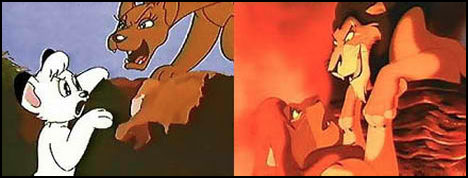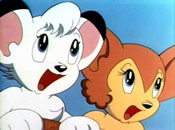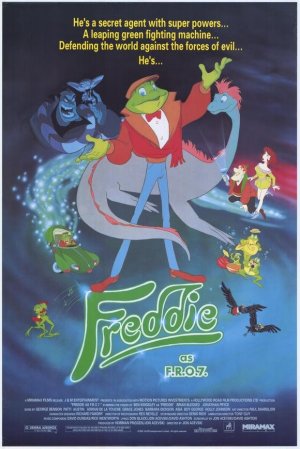
The Lyin’ King. In a July 13, 1994 Los Angeles Times article by Robert Welkos, Takayuki Matsutanti, president of Tezuka Productions in Tokyo stated that while there were some apparent similarities between Disney’s recently released feature The Lion King (1994) and Osamu Tezuka’s much earlier TV series Kimba, The White Lion (1965) that “quite a few staff of our company saw a preview of The Lion King, discussed this subject and came to the conclusion that you cannot avoid having these similarities as long as you use animals as characters and try to draw image out of them.
 “If the Disney Company had gotten a hint from The Jungle Emperor, Osamu Tezuka, a founder of our company would have been pleased. And we feel the same way, rather than making a claim. Therefore, our company’s general opinion is The Lion King is a totally different piece from The Jungle Emperor and is an original work completed by the Disney productions long-lasting excellent production technique.”
“If the Disney Company had gotten a hint from The Jungle Emperor, Osamu Tezuka, a founder of our company would have been pleased. And we feel the same way, rather than making a claim. Therefore, our company’s general opinion is The Lion King is a totally different piece from The Jungle Emperor and is an original work completed by the Disney productions long-lasting excellent production technique.”
 The same article had co-director Rob Minkoff (who claimed only to have learned of the controversy on a recent trip to Japan to promote the Disney film) saying, “Frankly, I’m not familiar with the TV series. I know for a fact that (Kimba) has never been discussed as long as I’ve been on the project (April 1992). In my experience, if Disney becomes aware of anything like that, they say you will not do it. People are claiming copyright infringement all the time.”
The same article had co-director Rob Minkoff (who claimed only to have learned of the controversy on a recent trip to Japan to promote the Disney film) saying, “Frankly, I’m not familiar with the TV series. I know for a fact that (Kimba) has never been discussed as long as I’ve been on the project (April 1992). In my experience, if Disney becomes aware of anything like that, they say you will not do it. People are claiming copyright infringement all the time.”
By the way, Tezuka met Walt Disney at the 1964-65 New York World’s Fair and Walt was familiar, and apparently complimentary, about Tezuka’s Astro Boy. In a 1986 entry in his personal diary, Tezuka stated that Disney wanted to hire him for a potential science fiction project.
Yogi Bear Whoremonger. In February 1993, Bill Hanna who was then 82 years old was interviewed in USA Today by Jefferson Graham and Hanna did not care for all the updating of classic Hanna-Barbera characters. In reference to NBC’s 1991 Saturday morning animated series Yo, Yogi!, Hanna didn’t hesitate to say, “They screwed it up by re-designing him. They made him look like a whoremonger. If you have something that works, don’t screw it up!”
 Cel Out. In TV Guide for January 9, 1993, when informed that at a recent Christie’s auction a cel of Ren and Stimpy sold for $3,850, creator John Kricfalusi said, “Cels are just not worth thousands of dollars. They’re not that hard to make. It takes about five minutes to paint one. I can’t even afford to buy a Ren and Stimpy cel.”
Cel Out. In TV Guide for January 9, 1993, when informed that at a recent Christie’s auction a cel of Ren and Stimpy sold for $3,850, creator John Kricfalusi said, “Cels are just not worth thousands of dollars. They’re not that hard to make. It takes about five minutes to paint one. I can’t even afford to buy a Ren and Stimpy cel.”
The Itchy and Scratchy That Never Was. According to Inside Media magazine March 2, 1993, Twentieth Century Fox wanted desperately to produce a series of Itchy and Scartchy short theatrical cartoons to run before Fox feature films. “We talked about it,” said creator Matt Groening, “but it would be hard to sustain for seven minutes.”
 Turner on Roger Rabbit. From Los Angeles Times June 23, 1988, actress Kathleen Turner who did the voice of Jessica Rabbit in Who Framed Roger Rabbit said she did the uncredited role “largely out of friendship and fun. Bob (Zemeckis who directed her in Romancing the Stone) proposed this to me as a neat thing to do in a new kind of film and I said, ‘Swell’. And I really kind of wanted it to be like that just for that reason.”
Turner on Roger Rabbit. From Los Angeles Times June 23, 1988, actress Kathleen Turner who did the voice of Jessica Rabbit in Who Framed Roger Rabbit said she did the uncredited role “largely out of friendship and fun. Bob (Zemeckis who directed her in Romancing the Stone) proposed this to me as a neat thing to do in a new kind of film and I said, ‘Swell’. And I really kind of wanted it to be like that just for that reason.”
Fleischer on Roger Rabbit. From the Los Angeles Times June 23, 1988, Charles Fleischer who did the voice of Roger Rabbit in Who Framed Roger Rabbit said, “I would be happy to do Roger Rabbit for the rest of my life. I love Roger. I think he’s the greatest cartoon character of all time. There’s never been a cartoon character with Roger’s depth. As great as I think Mickey Mouse is, I don’t think he could sustain a feature.”
Dissecting the Dead Frog. In Variety for September 20, 1992 it was revealed that Hollywood Road Film Productions had laid off all its remaining staff. The company was the producer of the then recently released animated feature Freddie as F.R.O.7 (1992), a spoof of spy films with a prince who is turned into a six foot tall frog who later becomes a top agent in the French secret service.
 He journeys to England to find out what happened to missing buildings like the Tower of London and Buckingham Palace. The film was billed as “the most ambitious animation project ever made in Britain and will out-Disney Disney”.
He journeys to England to find out what happened to missing buildings like the Tower of London and Buckingham Palace. The film was billed as “the most ambitious animation project ever made in Britain and will out-Disney Disney”.
Hollywood Road Film Productions had also suspended production on the announced sequel Freddie Goes to Washington which had been budgeted at twenty-two million dollars and had twelve minutes of footage already completed. The company’s backers were believed to have lost about twenty-five million dollars on the poorly received movie.
The film had cost eighteen million dollars to produce with an additional five million dollars toward U.S. distribution costs and one-and-a-half million dollars for the U.K. release. In its initial release, the film earned roughly one million dollars and was labelled a “cartoon catastrophe”.
Motion Pictures Investments president Sherman Baldwin stated, “We keep hearing there is a need for family entertainment, and we would assume that critics would take that into consideration in their reviews but they don’t. You hope that you can get full runs everywhere but we didn’t. That’s just the reality of the marketplace.
“We’re big boys and sometimes these things don’t work out. We’re just happy that this wasn’t a hundred million dollar picture that we put fifty million into. We’ll move on to the next picture.”
Hurting the film was the absence from the publicity campaign tour of actor Ben Kingsley who voiced the role of Freddie but had conflicting commitments.
“We were supposed to have him to promote the picture for at least two weeks,” stated Miramax’s Gerry Rich. “We had a lot of things lined up and we would have had him on every major TV show that made sense. Having him endorse the movie would have really legitimized the film. Unless you have an Amblin release or a Disney release, it’s difficult.
“We were trying to keep every print working as much as possible (The film opend on about 1,250 screens.) but full bookings were impossible. Investors knew that. That was made clear at the very beginning. There were no surprises on opening day.”


 Jim Korkis is an internationally respected animation historian who in recent years has devoted his attention to the many worlds of Disney. He was a columnist for a variety of animation magazines. With his former writing partner, John Cawley, he authored several animation related books including The Encyclopedia of Cartoon Superstars, How to Create Animation, Cartoon Confidential and Get Animated’s Animation Art Buyer’s Guide. He taught animation classes at the Disney Institute in Florida as well as instructing classes on acting and animation history for Disney Feature Animation: Florida.
Jim Korkis is an internationally respected animation historian who in recent years has devoted his attention to the many worlds of Disney. He was a columnist for a variety of animation magazines. With his former writing partner, John Cawley, he authored several animation related books including The Encyclopedia of Cartoon Superstars, How to Create Animation, Cartoon Confidential and Get Animated’s Animation Art Buyer’s Guide. He taught animation classes at the Disney Institute in Florida as well as instructing classes on acting and animation history for Disney Feature Animation: Florida.




















































On Yo Yogi! It was the last (thank goodness) of legendary H-B in kid/tween style. Following The Flintstone Kids,A Pup Named Scooby Doo and Tom & Jerry Kids I was horrified at the way that they turned Yogi, Boo Boo, Cindy, Huck and Snagglepuss into Mall Rats as well as Jellyston Park turning into a mall and turning Ranger Smith into a Mall Cop and Magilla Gorilla into a rapper named Magilla Ice. No wonder why one patental group called Yo Yogi! “a stupid series” and was cancelled a year later. The only legacy that the Ill fated series had was the theme song from Yo Yogi! was preformed during the Orange Bowl halftime spectacular that year.
I remember “Freddy the F.R.O.7”. From 1992, (I remember Boy George was in it!). Tom and Jerry Kids and Muppet Babies seemed to go for the opposite of Yo, Yogi (or Tiny Toons which had some of the same voices.)
As I know of of Frank Welker appeared in all four series (Muppet Babies,Tom & Jerry Kids,Tiny Toons and Yo Yogi). While Don Messick appeared in Tom and Jerry Kids,Tiny Toons and Yo Yogi, Charlie Alder appeared in Tiny Toons and Tom & Jerry Kids and Greg Berg appeared in Muppet Babies and Yo Yogi.
Tezuka’s wife was on the record saying that since he had a tremendous respect for Disney, she could never think of actively suing them for copyright infringement. I think Billie Lou Watt hinted that the film was a rip-off in her words..
There were several scenes that looked liked The Lion King “copied” Kimba the White Lion. One of the most notable was the scene Baby Kimba was floating on top of the wreckage of the freighter that carried him and his late mother (his father was murdered by poachers) he seen in the stars on a clear beautiful night the image of his late mother urging zKimba to keep going and continue swimming to the mainland. In The Lion King Simba now a adult and unsure about what’s going on went to a cliff and seen the image of his late father Mufasta forming in the thunderhead urging Simba to go on and avenge him. Also the Rafiki character as well as the hyenas on the Lion King were loosely based on Daniel Baboon (who was more like a Mandrill than a Baboon) and the two hyenas a tall one and the squatty one that kind of reminded me of Van Buren’s Tom & Jerry.
Being the founders of the studios, you’d think the H-B staff would ask for final approval of a concept from both Joe AND Bill before doing a series. I’d think the studio would’ve gone much smoother that way and have less bruises.
Sadly that wasn’t the case with the following series that H-B animated such as:
Popeye and Son, The second run of Snorks on syndication, Pink Panther and Sons, A Pup Named Scooby Doo, The New Pound Puppies, Partridge Family 2200 A.D., The Thing, The Fonz and the Happy Days Gang, Casper and the Angels and The Flintstone Kids.
I have the press kit for Yo, Yogi!. In it they compared his smart alecky-ness to Bart Simpson. Seriously.
Oh Gawd, having a Teenage Yogi Bear acting like Bart Simpson as to paraphrase in a sarcastically parody of Yogi’s classic quote “That’s not smarter than a average bear”!
This is a pretty thorough review of Freddie as F.R.O.7. showing how bad and inconsistent it is:
https://www.youtube.com/watch?v=nEf52nU4PPE
Two of my colleagues with the Festival of Animation back in the day were on a TV show with Charles Fleischer, and had only the WORST things to say about him. He was a diva, demanding and rude to those “beneath” him, completely unfriendly and grand. I wonder if the years have mellowed him?
If I may, some food for thought regarding Disney’s “borrowing” from “Jungle Emperor/Kimba”.
I’ve done a lot of research and given this much thought, and although over time I have softened my position from infringement to inspiration, I have doubts about Tezuka Productions’ “official” and public stance on this matter. My personal feeling is that they made this statement because they don’t want to appear indignant towards a high profile company such as Disney; how they really feel may not be what they state publicly.
Another interesting viewpoint: From the magazine: “Mangajin”, no. 42, February 1995, pp. 4 and 34. “Letters to the Editor” – “Kimba Versus Simba”: A letter from Stephanie Tomiyasu, of Yokohama, asks for the magazine’s opinion of the Lion King controversy, especially in regard to the fact that “the Japanese say such things as that Tezuka would be pleased to have influenced a Disney film” while if the issue had arisen between two American companies, ‘the case would have been in court long ago. Doesn’t this whole thing say something about the Japanese?” The magazine asked Tezuka expert Frederik Schodt for his opinion. Schodt replied that ” … ‘borrowing’ is very common in animation; but that “Disney’s public assertion that its hundreds of production staff members had never even heard of the late Tezuka Osamu or his work – is preposterous.”
(From Fred Patten’s 2004 book: ‘Watching Anime, Reading Manga., p. 181.)